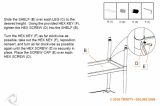3
Warranty and Returns
Specifications
Motor..............................................................3 HP, 18A, 220V, Single-Phase
Maximum Cutting Width......................................................................14
7
⁄8"
Maximum Cutting Height ......................................................................6
1
⁄8"
Maximum Depth of Cut ..........................................................................
1
⁄8"
Minimum Stock Thickness ......................................................................
3
⁄16"
Minimum Stock Length ............................................................................8"
Cutterhead Diameter ..............................................................................3"
Cutterhead Speed ......................................................................5,000 RPM
Cuts Per-Minute ..............................................................................15,000
Approximate Handwheel Rotation-to-Cutterhead Travel ................360º=
5
⁄32" (4mm)
Table Size W/Extensions ..............................................................14
7
⁄8" x 48"
Dust Port Size ......................................................................................4"
Feed Rates ..........................................................................16 and 20 FPM
Cuts Per-Inch..............................................................................63 and 78
Power Cord ..................................................................................12 AWG
Knives (W1723) ............................................................3 Straight HSS Knives
Footprint and Overall Height (W1723)..........25
1
⁄2" Wide x 25
1
⁄2" Deep and 47
1
⁄2" High
Approximate Machine Weight (W1723)..................................................410 lbs.
Knives (W1724) ................................................................3 Spiral HSS Knives
Footprint and Overall Height (W1724) ................21
1
⁄2" Wide x 21
1
⁄2" and 47
1
⁄2" High
Approximate Machine Weight (W1724) ................................................450 lbs.
Woodstock International, Inc. warrants all SHOP FOX
®
machinery to be free of defects from
workmanship and materials for a period of 2 years from the date of original purchase by the original
owner. This warranty does not apply to defects due directly or indirectly to misuse, abuse, negligence
or accidents, lack of maintenance, or to repair or alterations made or specifically authorized by
anyone other than Woodstock International, Inc.
Woodstock International, Inc. will repair or replace, at its expense and at its option, the
SHOP FOX
®
machine or machine part which in normal use has proven to be defective, provided that the original
owner returns the product prepaid to the
SHOP FOX
®
factory service center or authorized repair
facility designated by our Bellingham, WA office, with proof of their purchase of the product within 2
years, and provides Woodstock International, Inc. reasonable opportunity to verify the alleged defect
through inspection. If it is determined there is no defect, or that the defect resulted from causes not
within the scope of Woodstock International Inc.'s warranty, then the original owner must bear the
cost of storing and returning the product.
This is Woodstock International, Inc.'s sole written warranty and any and all warranties that may be
implied by law, including any merchantability or fitness, for any particular purpose, are hereby
limited to the duration of this written warranty. We do not warrant that
SHOP FOX
®
machinery
complies with the provisions of any law or acts. In no event shall Woodstock International, Inc.'s
liability under this warranty exceed the purchase price paid for the product, and any legal actions
brought against Woodstock International, Inc. shall be tried in the State of Washington, County of
Whatcom. We shall in no event be liable for death, injuries to persons or property or for incidental,
contingent, special or consequential damages arising from the use of our products.
Every effort has been made to ensure that all
SHOP FOX
®
machinery meets high quality and durability
standards. We reserve the right to change specifications at any time because of our commitment to
continuously improve the quality of our products.
INTRODUCTION






















